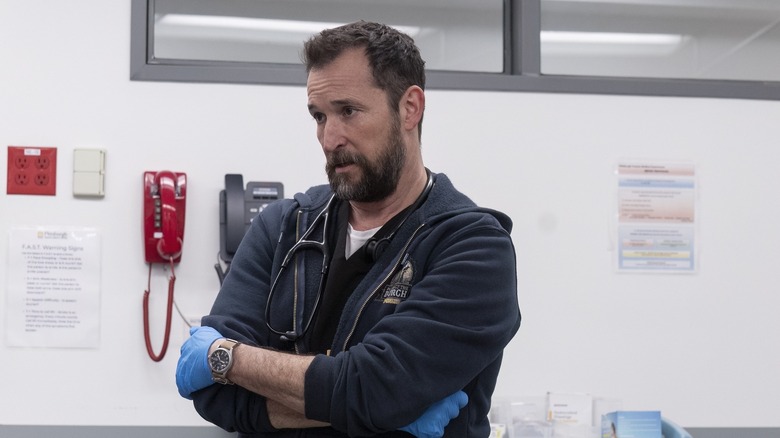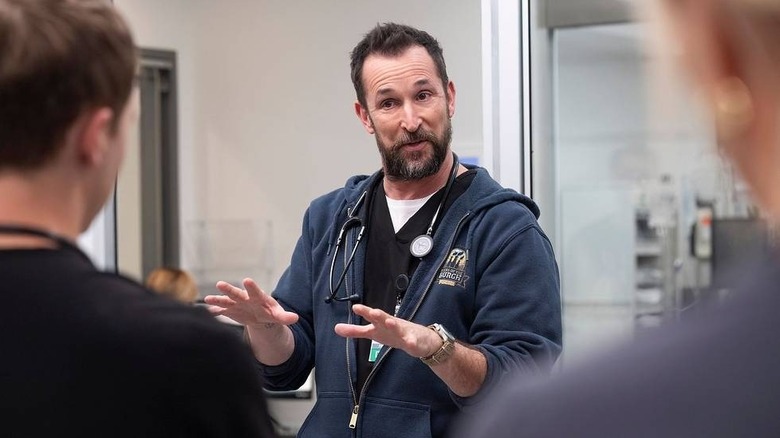How Much The Pitt Costs Per Episode
After "The Pitt," a medical drama that takes place in "real time" across a 15-hour shift at a fictional Pittsburgh hospital (albeit with filming locations that include the exterior of a real Pittsburgh hospital), premiered on Max in January 2025, the series became an immediate hit ... and you might be surprised that, compared to other HBO juggernauts, it's relatively cheap to produce.
In a feature about the series' success by IndieWire, executive producer and director John Wells — who came up with the idea for the series with his fellow "ER" veterans and friends R. Scott Gemmill (who serves as showrunner) and Noah Wyle (who stars as Dr. Michael "Robby" Robinavitch) — revealed that the series costs about $4 or $5 million per episode. For context, the first season of "The Last of Us" worked with a total budget of around $100 million, which came out to around $10 million per episode. (Also, just to clarify — even though Wells, Gemmill, and Wyle all worked together on "ER," this show is, for legal reasons, not a spin-off or a reboot.)
Wells explained to the outlet that the series' creatives were able to keep costs pretty low thanks to the show's primary practical hospital set. "We weren't trying to create a tremendous amount of CGI or anything," Wells noted. "We had to do a certain amount of it for some of the wound work. We weren't shooting in open spaces surrounded by 300 yards of blue screen."
It's also important to note here that most HBO and Max shows run for around 10 episodes, though this isn't set in stone; season 2 of "The Last of Us" is spread across only seven episodes, while the third season of "The White Lotus" ran for eight chapters. Plus, as Wells pointed out, most doctors work 12-hour shifts. However, for both storytelling purposes and to appease a request from Max, the show's creators bumped season 1's episode count to 15, and it was still cost-effective for Max.
"But for the physicians and nurses, there is a tremendous amount of time it takes to hand off all your patients to the next shift that's coming," Wells mused. "But the 15 ended up being because Max said to us, 'Can you do 15 hours?' And we said, 'Sure.' That's big. But a lot of the shows that were on HBO, like 'The Sopranos,' were 12 episodes. The reduced episodes has been in large part attached to the cost of making these shows where you have these big world-building, difficult shows. There aren't that many places that are going to spend or can afford to do 10, 12, or 15 hours of that because they're so expensive. So, when you get a 'House of the Dragon' or 'The Last of Us' or 'Severance,' shows that are so expensive to make, you're not going to make 15 of them. It's just not an economic reality."
John Wells believes that The Pitt's commitment to medical accuracy helped it grow its audience
"The Pitt," which is already set to return for a second season as soon as January 2026, has been a huge critical and commercial hit for HBO and Max; according to an article in Variety after season 1 concluded, the season average came out to a whopping 10 million viewers per episode. So, why does John Wells think this show hit so hard?
"We're living in complicated times," Wells told IndieWire. "The show is presenting hard-working, blue-collar people who are trying to make a difference, and are coming at their work every day in a certain way, bringing a lot of dedication in very difficult circumstances, with some integrity and a moral compass and saying, 'Look, I can't change the world. I can do this today. I can do this in this one-hour period or this two-hour period.' People do find comfort in that. They find something to admire in it, which we need."
Not only that, but anyone watching "The Pitt" — or, frankly, reading this very article — has probably had some sort of experience in a real-life emergency room as well. Hence, Wells, Noah Wyle, and R. Scott Gemmill wanted the scenarios depicted on screen to both feel real and highlight the incredibly hard work and tasks performed by ER physicians and nurses alike. As Wells put it:
"The fact that we're showing just how difficult the emergency room situation is in the country means that people go, 'Oh, that's true. That's the experience that happened for me and that I see some people who are actually trying to make a difference.' They're there. They can be doing any number of other things. All these physicians could be making two and three times more by trying to do a different specialty. And they're actually there to care for the people who need it, usually in the most dire circumstances, or you simply have no other health care."
Because The Pitt is on Max, John Wells and his colleagues can show all the gory details found within the ER
There's one thing that definitely sets "The Pitt" apart from other medical dramas — and you might notice this pretty quickly, because the series featured a gruesome degloved ankle in its very first episode. Again, a lot of this boils down to a commitment to realism; as John Wells told IndieWire, the creative team behind the series was determined to show what's really been happening in emergency rooms, particularly since the advent of the COVID-19 crisis.
"What came back from every single physician and nurse we spoke to was it's become increasingly dangerous to work in the emergency room," Wells said of the team's extensive research. "The hospital version of road rage has become much more prevalent as tensions within the country went up since COVID. Everybody's on edge, and that has gone into the emergency rooms. One of the things they encounter all the time is people who have not adequately addressed the wishes of their parents as they get old, who haven't done a living will or have done one but don't respect it. The Fentanyl crisis and all these things came up, including the humorous ones and the crazy stuff that's on the internet, where there's all this stuff you can buy that has mercury in it, people getting mercury poisoning from facial products from Korea that nobody's paying any attention to."
The freedom to show the most violent and, again, gruesome aspects of medical care — because "The Pitt" doesn't have to adhere to network restrictions like "ER" once did on NBC or "Grey's Anatomy" still does on ABC — helped push the show even further when it came to being medically accurate. "In going back to doing a medical show, it would have only been valuable if we could do it so we're on a ride along with emergency room physicians over their shoulder, you're seeing what they see," Wells revealed. "And some of our admiration for what they do that the audience is taking away is seeing what they actually emotionally deal with all day long, and physically, what they deal with, how physical the job is, what they're actually seeing, how graphic it is."
"The Pitt," with all its realism and gruesome details, is streaming on Max now ... and it's one of the streamer's biggest hits in 2025 for good reason.


